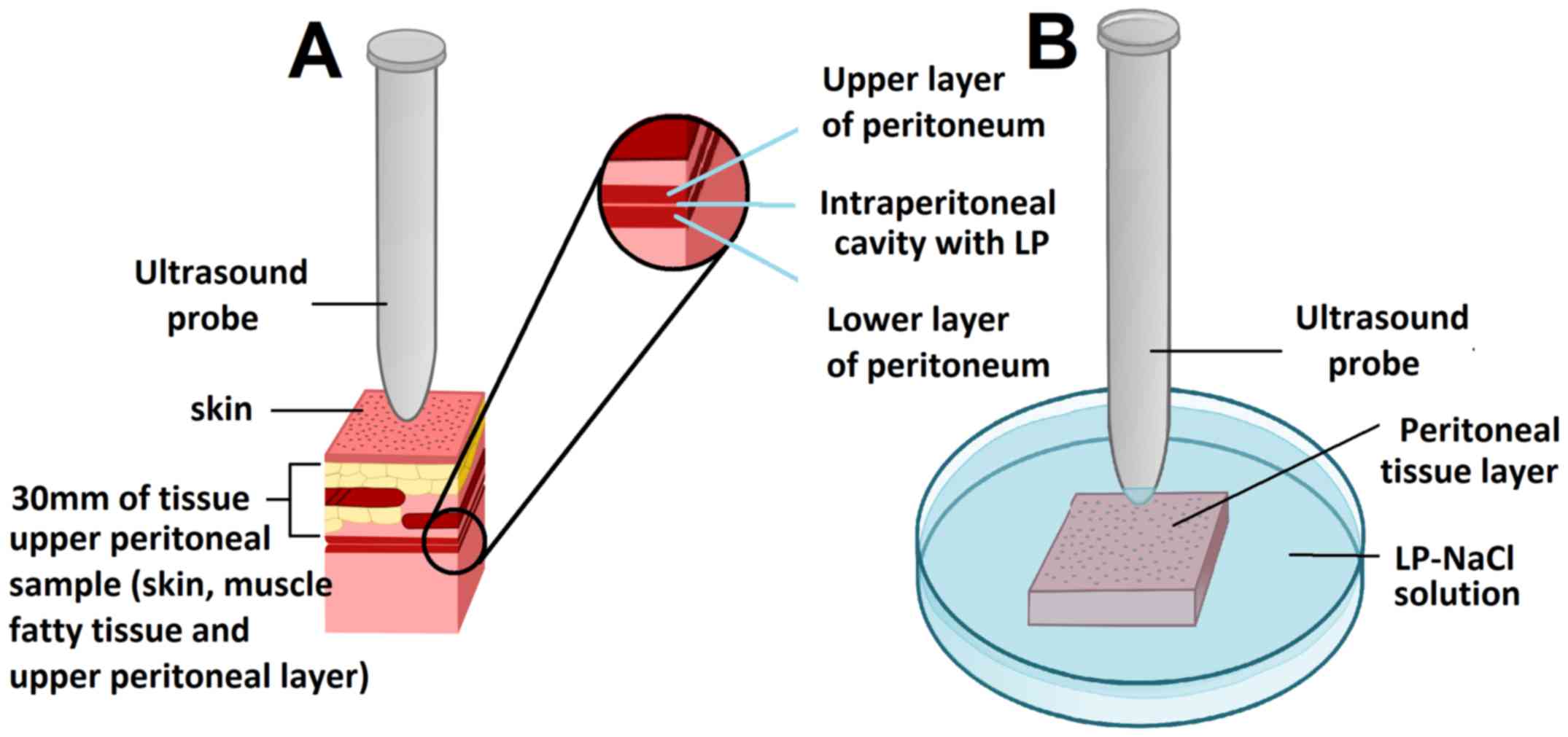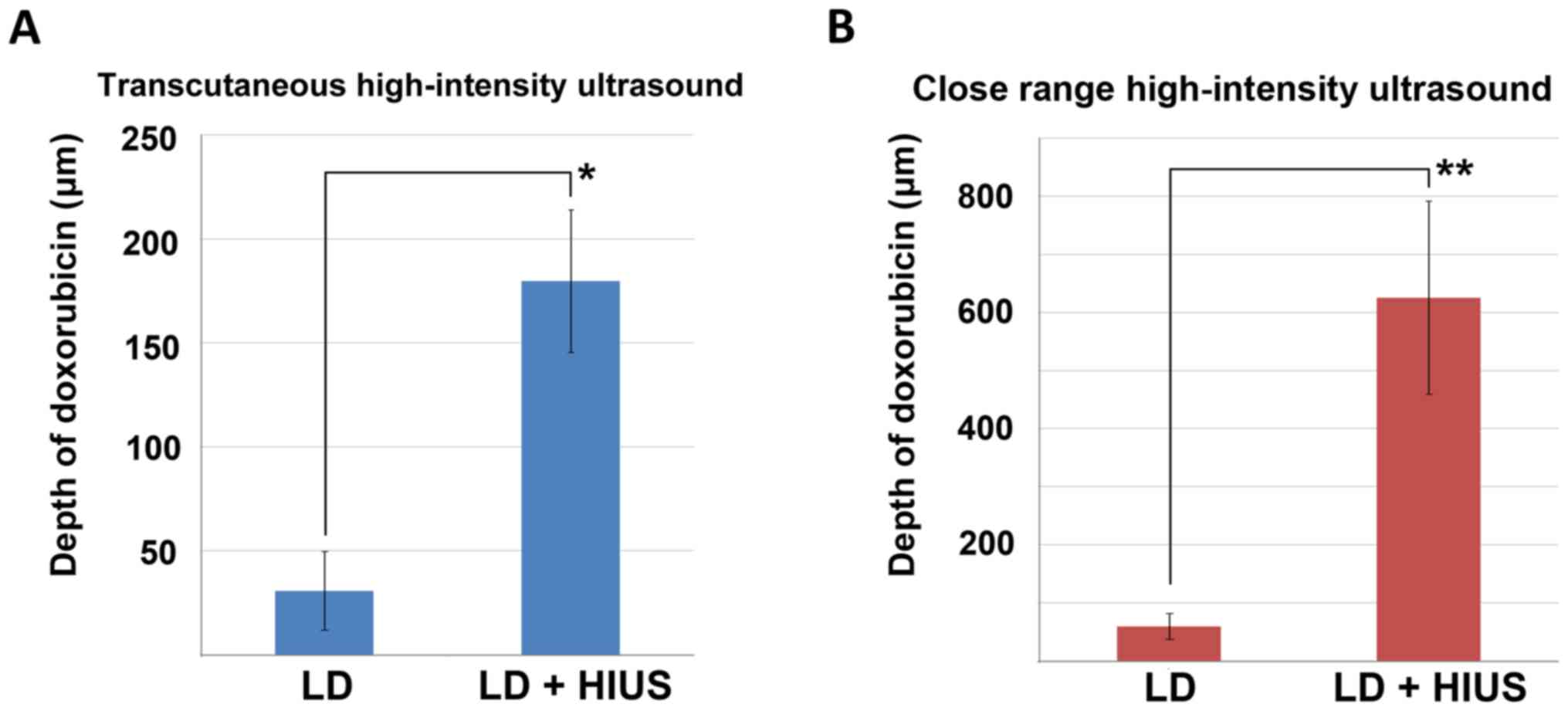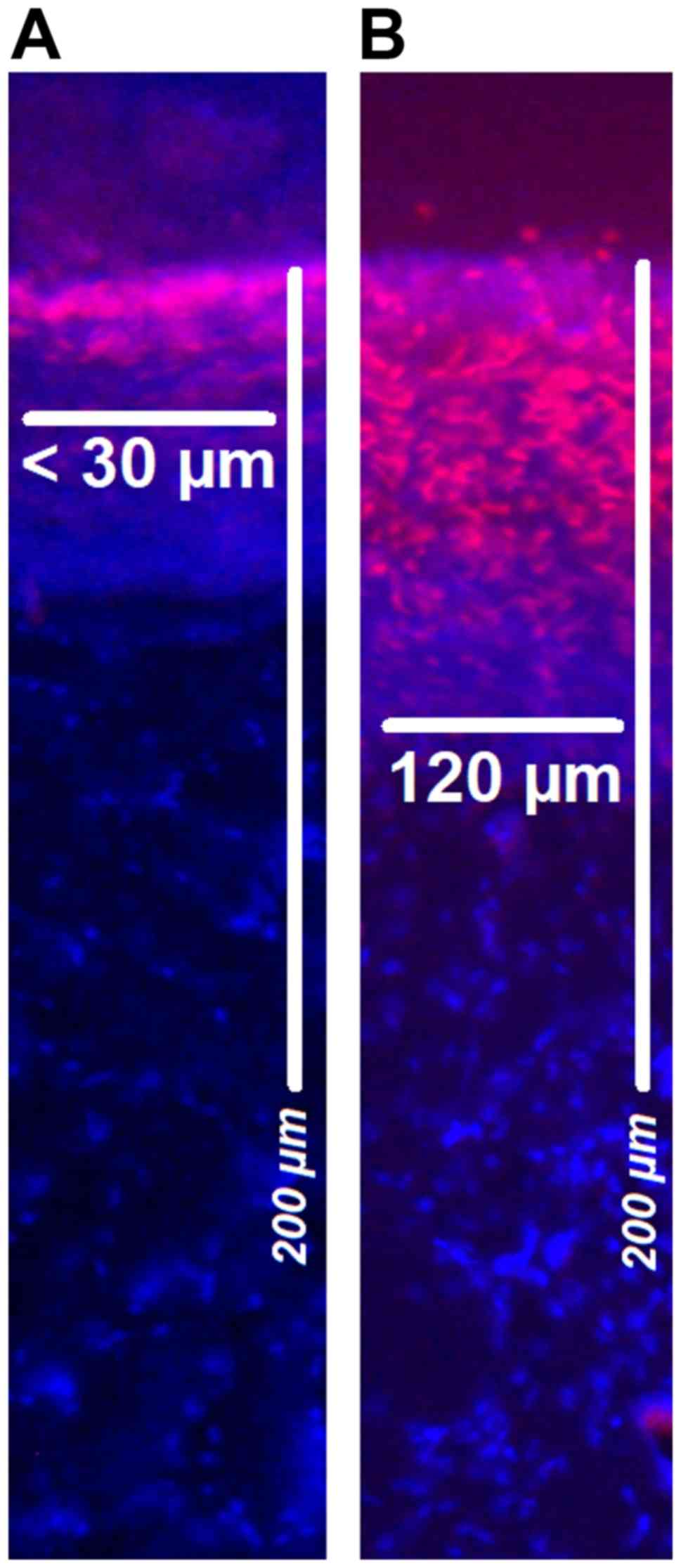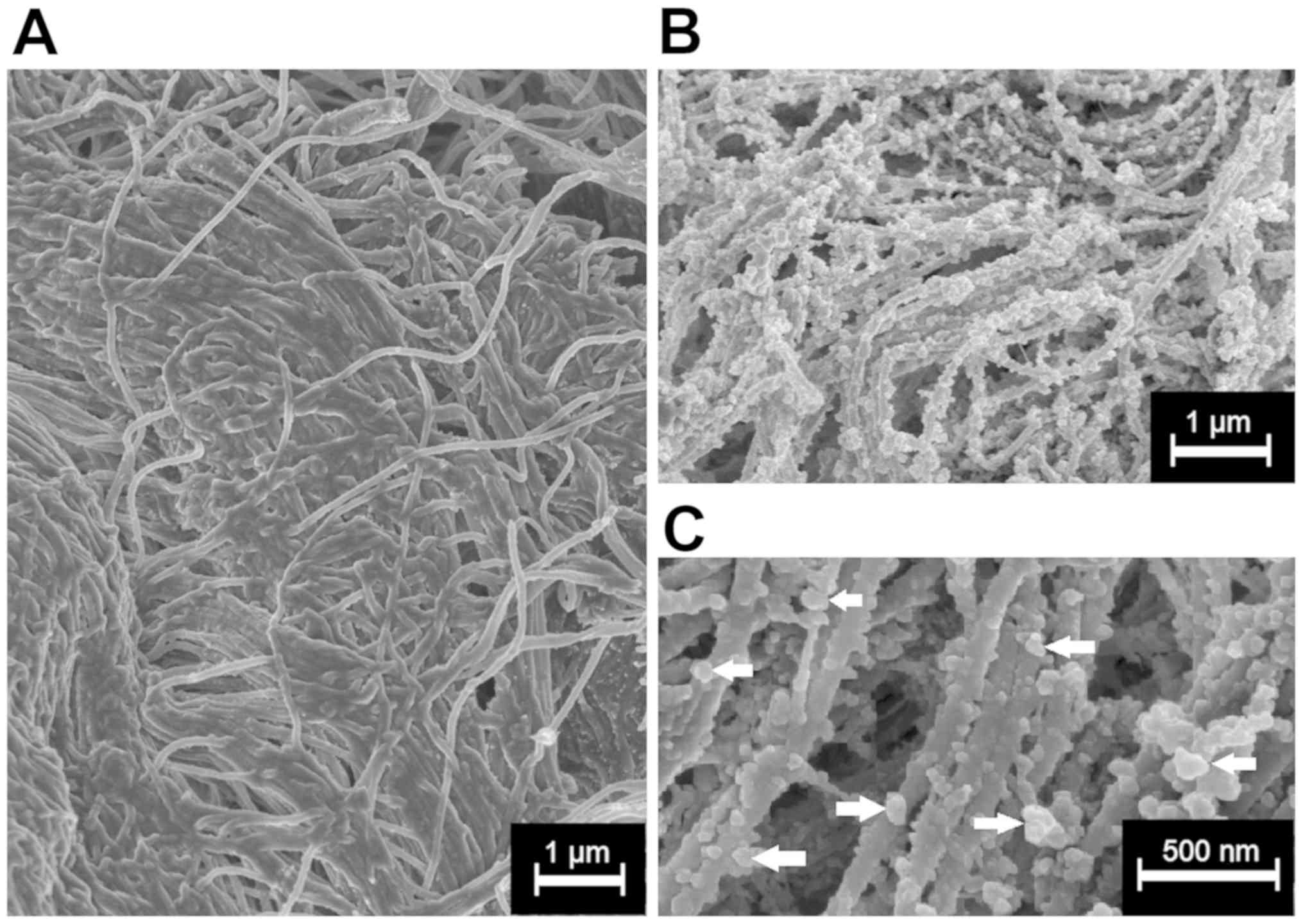|
1
|
Solass W, Kerb R, Mürdter T, Giger-Pabst
U, Strumberg D, Tempfer C, Zieren J, Schwab M and Reymond MA:
Intraperitoneal chemotherapy of peritoneal carcinomatosis using
pressurized aerosol as an alternative to liquid solution: First
evidence for efficacy. Ann Surg Oncol. 21:553–559. 2014. View Article : Google Scholar : PubMed/NCBI
|
|
2
|
Göhler D, Khosrawipour V, Khosrawipour T,
Diaz-Carballo D, Falkenstein TA, Zieren J, Stintz M and Giger-Pabst
U: Technical description of the microinjection pump
(MIP®) and granulometric characterization of the aerosol
applied for pressurized intraperitoneal aerosol chemotherapy
(PIPAC). Surg Endosc. 31:1778–1784. 2017. View Article : Google Scholar : PubMed/NCBI
|
|
3
|
Khosrawipour V, Khosrawipour T, Kern AJ,
Osma A, Kabakci B, Diaz-Carballo D, Förster E, Zieren J and
Fakhrian K: Distribution pattern and penetration depth of
doxorubicin after pressurized intraperitoneal aerosol chemotherapy
(PIPAC) in a postmortem swine model. J Cancer Res Clin Oncol.
142:2275–2280. 2016. View Article : Google Scholar : PubMed/NCBI
|
|
4
|
Khosrawipour V, Khosrawipour T,
Falkenstein TA, Diaz-Carballo D, Förster E, Osma A, Adamietz IA,
Zieren J and Fakhrian K: Evaluating the effect of micropump©
position, internal pressure and doxorubicin dosage on efficacy of
pressurized intra-peritoneal aerosol chemotherapy (PIPAC) in an ex
vivo model. Anticancer Res. 36:4595–4600. 2016. View Article : Google Scholar : PubMed/NCBI
|
|
5
|
Khosrawipour V, Khosrawipour T,
Diaz-Carballo D, Förster E, Zieren J and Giger-Pabst U: Exploring
the spatial drug distribution pattern during pressurized
intraperitoneal aerosol chemotherapy (PIPAC). Ann Surg Oncol.
23:1220–1224. 2016. View Article : Google Scholar : PubMed/NCBI
|
|
6
|
Khosrawipour T, Schubert J, Khosrawipour
V, Chaudhry H, Grzesiak J, Arafkas M and Mikolajczyk A: Particle
stability and structure on the peritoneal surface in pressurized
intra-peritoneal aerosol chemotherapy (PIPAC) analysed by electron
microscopy: First evidence of a new physical concept for PIPAC.
Oncol Lett. 17:4921–4927. 2019.PubMed/NCBI
|
|
7
|
Mikolajczyk A, Khosrawipour V, Schubert J,
Grzesiak J, Chaudhry H, Pigazzi A and Khosrawipour T: Effect of
liposomal doxorubicin pressurized intra-peritoneal aerosol
chemotherapy (PIPAC). J Cancer. 9:4301–4305. 2018. View Article : Google Scholar : PubMed/NCBI
|
|
8
|
Khosrawipour V, Khosrawipour T,
Hedayat-Pour Y, Diaz-Carballo D, Bellendorf A, Böse-Riberio H,
Mücke R, Mohanaraja N, Adamitz IA and Fakhrian K: Effect of whole
abdominal irradiation on penetration depth of doxorubicin in normal
tissue after pressurized intraperitoneal aerosol chemotherapy
(PIPAC) in a post-mortem swine model. Anticancer Res. 37:1677–1680.
2017. View Article : Google Scholar : PubMed/NCBI
|
|
9
|
Khosrawipour V, Bellendorf A, Khosrawipour
C, Hedayat-Pour Y, Diaz-Carballo D, Förster E, Mücke R, Kabakci B,
Adamietz IA and Fakhrian K: Irradiation does not increase the
penetration depth of doxorubicin in normal tissue after pressurized
intra-peritoneal aerosol chemotherapy (PIPAC) in an ex vivo model.
In Vivo. 30:593–597. 2016.PubMed/NCBI
|
|
10
|
Khosrawipour V, Giger-Pabst U,
Khosrawipour T, Pour YH, Diaz-Carballo D, Förster E, Böse-Ribeiro
H, Adamietz IA, Zieren J and Fakhrian K: Effect of irradiation on
tissue penetration depth of doxorubicin after pressurized
intra-peritoneal aerosol chemotherapy (PIPAC) in a novel ex-vivo
model. J Cancer. 7:910–914. 2016. View Article : Google Scholar : PubMed/NCBI
|
|
11
|
Harrison LE, Bryan M, Pliner L and
Saunders T: Phase I trial of pegylated liposomal doxorubicin with
hyperthermic intraperitoneal chemotherapy in patients undergoing
cytoreduction for advanced intra-abdominal malignancy. Ann Surg
Oncol. 15:1407–1413. 2008. View Article : Google Scholar : PubMed/NCBI
|
|
12
|
Salvatorelli E, De Tursi M, Menna P,
Carella C, Massari R, Colasante A, Iacobelli S and Minotti G:
Pharmacokinetics of pegylated liposomal doxorubicin administered by
intraoperative hyperthermic intraperitoneal chemotherapy to
patients with advanced ovarian cancer and peritoneal
carcinomatosis. Drug Metab Dispos. 40:2365–2373. 2012. View Article : Google Scholar : PubMed/NCBI
|
|
13
|
Hirano K and Hunt CA: Lymphatic transport
of liposome-encapsuled agents: Effect of liposome size following
intraperitoneal administration. J Pharm Sci. 74:915–921. 1985.
View Article : Google Scholar : PubMed/NCBI
|
|
14
|
Carron PL, Padilla M and Maurizi Balzan J:
Nephrotic syndrome and acute renal failure during pegylated
liposomal doxorubicin treatment. Hemodial Int. 18:846–847. 2014.
View Article : Google Scholar : PubMed/NCBI
|
|
15
|
Ansari L, Shiezadeh F, Taherzadeh Z,
Nikoofal-Sahlabadi S, Momtazi-Borojeni AA, Sahebkar A and Eslami S:
The most prevalent side effects of pegylated liposomal doxorubicin
monotherapy in women with metastatic breast cancer: A systemic
review of clinical trials. Cancer Gene Ther. 24:189–193. 2017.
View Article : Google Scholar : PubMed/NCBI
|
|
16
|
Rizzitelli S, Guistetto P, Faletto D,
Delli Castelli D, Aime S and Terreno E: The release of Doxorubicin
from liposomes monitores by MRI and triggered by a combination of
US stimuli led to a complete tumor regression in a breast cancer
mouse model. J Control Release. 230:57–63. 2016. View Article : Google Scholar : PubMed/NCBI
|
|
17
|
Lyon PC, Griffiths LF, Lee J, Chung D,
Carlise R, Wu F, Middelton MR, Gleeson FV and Coussios CC: Clinical
trial protocol for Tardox: A phase I study to investigate the
feasibility of target release of lyso-thermosensitive liposomal
doxorubicin (ThermoDox®) using focused ultrasound in
patients with liver tumors. J Ther Ultrasound. 5:282017. View Article : Google Scholar : PubMed/NCBI
|
|
18
|
Khosrawipour V, Diaz-Carballo D, Acikelli
AH, Khosrawipour T, Falkenstein TA, Wu D, Zieren J and Giger-Pabst
U: Erratum to: Cytotoxic effect of different treatment parameters
in pressurized intraperitoneal aerosol chemotherapy (PIPAC) on the
in vitro proliferation of human colonic cancer cells. World J Surg
Oncol. 15:942017. View Article : Google Scholar : PubMed/NCBI
|
|
19
|
Khosrawipour V, Mikolajczyk A, Schubert J
and Khosrawipour T: Pressurized intra-peritoneal aerosol
chemotherapy (PIPAC) via endoscopical microcatheter system.
Anticancer Res. 38:3447–3452. 2018. View Article : Google Scholar : PubMed/NCBI
|
|
20
|
Flessner MF, Choi J, Credit K, Deverkadra
R and Henderson K: Resistance of tumor intestinal pressure to the
penetration of intraperitoneally delivered antibodies into
metastatic ovarian tumors. Clin Cancer Res. 11:3117–3125. 2005.
View Article : Google Scholar : PubMed/NCBI
|
|
21
|
Holzer AK, Katano K, Klomp LW and Howell
SB: Cisplatin rapidly down-regulates its own influx transporter
hCTR1 in cultured human ovarian carcinoma cells. Clin Cancer Res.
10:6744–6749. 2004. View Article : Google Scholar : PubMed/NCBI
|
|
22
|
Mikolajczyk A, Khosrawipour V, Schubert J,
Plociennik M, Nowak K, Fahr C, Chaudhry H and Khosrawipour T:
Feasibility and characteristics of pressurized aerosol chemotherapy
(PAC) in the bladder as a therapeutical option in early-stage
urinary bladder cancer. In Vivo. 32:1369–1372. 2018. View Article : Google Scholar : PubMed/NCBI
|
|
23
|
Schubert J, Khosrawipour V, Chaudhry H,
Arafkas M, Knoefel WT, Pigazzi A and Khosrawipour T: Comparing the
cytotoxicity of taurolidine, mitomycin C, and oxaliplatin on the
proliferation of in vitro colon carcinoma cells following
pressurized intra-peritoneal aerosol chemotherapy (PIPAC). World J
Surg Oncol. 17:932019. View Article : Google Scholar : PubMed/NCBI
|
|
24
|
Mikolajczyk A, Khosrawipour V, Schubert J,
Chaudhry H, Pigazzi A and Khosrawipour T: Particle stability during
pressurized intra-peritoneal aerosol chemotherapy (PIPAC).
Anticancer Res. 38:4645–4649. 2018. View Article : Google Scholar : PubMed/NCBI
|
|
25
|
Sharma P, Mehta M, Dhanjal DS, Kaur S,
Gupta G, Singh H, Thangavelu L, Rajeshkumar S, Tambuwala M, Bakshi
HA, et al: Emerging trends in the novel drug delivery approaches
for the treatment of lung cancer. Chem Biol Interact.
309:1087202019. View Article : Google Scholar : PubMed/NCBI
|
|
26
|
Kai M, Ziemys A, Liu YT, Kojic M, Ferrari
M and Yokoi K: Tumor site-dependent transport properties determine
nanotherapeutics delivery and its efficacy. Transl Oncol.
12:1196–1205. 2019. View Article : Google Scholar : PubMed/NCBI
|
|
27
|
Lokerse WJM, Bolkestein M, Dalm SU,
Eggermont AMM, de Jong M, Grüll H and Koning GA: Comparing the
therapeutic potential of thermosensitive liposomes and hyperthermia
in two distinct subtypes of breast cancer. J Control Release.
258:34–42. 2017. View Article : Google Scholar : PubMed/NCBI
|
|
28
|
Falkenstein TA, Götze TO, Ouaissi M,
Tempfer CB, Giger-Pabst U and Demtröder C: First clinical data of
pressurized intraperitoneal aerosol chemotherapy (PIPAC) as salvage
therapy for peritoneal metastatic biliary tract cancer. Anticancer
Res. 38:373–378. 2018.PubMed/NCBI
|
|
29
|
Khosrawipour T, Khosrawipour V and
Giger-Pabst U: Pressurized intra peritoneal aerosol chemotherapy in
patients suffering from peritoneal carcinomatosis of pancreatic
adenocarcinoma. PLoS One. 12:e01867092017. View Article : Google Scholar : PubMed/NCBI
|
|
30
|
Armstrong DK, Fleming GF, Markman M and
Bailey HH: A phase I trial of intraperitoneal sustained-release
paclitaxel microspheres (Paclimer) in recurrent ovarian cancer: A
Gynecologic Oncology Group study. Gynecol Oncol. 103:391–396. 2006.
View Article : Google Scholar : PubMed/NCBI
|
|
31
|
Sugiyama T, Kumagai S, Nishida T, Ushijima
K, Matuso T, Yakushiji M, Hyon SH and Ikada Y: Experimental and
clinical evaluation of cisplatin-containing microspheres as
intraperitoneal chemotherapy for ovarial cancer. Anticancer Res.
18:2837–2842. 1998.PubMed/NCBI
|
|
32
|
Lyon PC, Gray MD, Mannaris C, Folkes LK,
Stratford M, Campo L, Chung DYF, Scott S, Anderson M, Goldin R, et
al: Safety and feasibility of ultrasound-triggered targeted drug
delivery of doxorubicin from thermosensitive liposomes in liver
tumours (TARDOX): A single-centre, open-label, phase 1 trial.
Lancet Oncol. 19:1027–1039. 2018. View Article : Google Scholar : PubMed/NCBI
|
|
33
|
Besse HC, Bos C, Zandvliet MMJM, van der
Wulff-Jacobs K, Moonen CTW and Deckers R: Triggered radiosensitizer
delivery using thermosensitive liposomes and hyperthermia improves
efficacy of radiotherapy: An in vitro proof of concept study. PLoS
One. 13:e02040632018. View Article : Google Scholar : PubMed/NCBI
|













